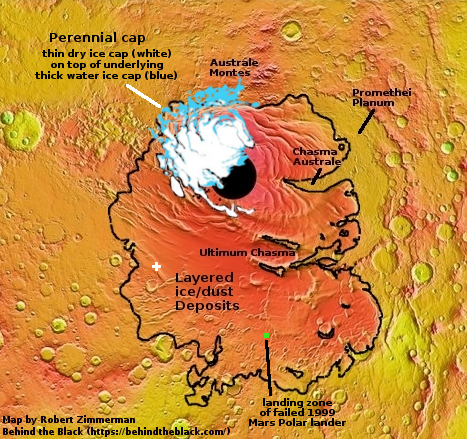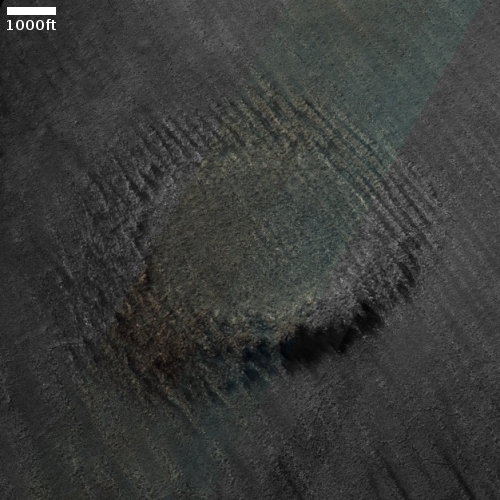A “what the heck?!” mesa in the southern polar regions of Mars
Cool image time! The photo to the right, rotated, cropped, and reduced to post here, was taken on July 28, 2022 by the high resolution camera on Mars Reconnaissance Orbiter (MRO). It shows what the scientists label a “Circular and Banded Landform.”
I put this mesa into a geological category I dub “What the heck?!” We are clearly looking at a mesa, probably no more than 200 feet high, if that. What makes it baffling are the parallel bands that not only cut across the mesa but extend in the same direction for many miles in all directions. Though at first glance these bands appear to be dunes, their rocky eroded look along the mesa’s northwest rim suggests instead the bands are the top edge of many vertically oriented parallel layers, which at this mesa’s flanks are eroding alternatively at different rates.
The overview map below shows us where this mesa is located, relative to the south pole.

The white cross marks the image’s location, about 400 miles from the south pole in the midst of what scientists have identified as a vast cap of layered ice/dust on which the much smaller south pole’s cap of ice and dry-ice sits.
Thus, the parallel bands here likely show us layers of dust and ice, laid down over the eons during the red planet’s many climate cycles, and then subsequently tilted vertically. That tilting was probably caused as new ice and dry ice was deposited at the pole and pushed these layers sideways away from that pole. (Think of a bulldozer pushing several layers of concrete to the side.) The faint color strip weakly supports this guess, as the bands in the mesa’s northeast quadrant appear to alternate vaguely between tan (dust) and aqua (ice?).
It is all a guess however.
On Christmas Eve 1968 three Americans became the first humans to visit another world. What they did to celebrate was unexpected and profound, and will be remembered throughout all human history. Genesis: the Story of Apollo 8, Robert Zimmerman's classic history of humanity's first journey to another world, tells that story, and it is now available as both an ebook and an audiobook, both with a foreword by Valerie Anders and a new introduction by Robert Zimmerman.
The print edition can be purchased at Amazon or from any other book seller. If you want an autographed copy the price is $60 for the hardback and $45 for the paperback, plus $8 shipping for each. Go here for purchasing details. The ebook is available everywhere for $5.99 (before discount) at amazon, or direct from my ebook publisher, ebookit. If you buy it from ebookit you don't support the big tech companies and the author gets a bigger cut much sooner.
The audiobook is also available at all these vendors, and is also free with a 30-day trial membership to Audible.
"Not simply about one mission, [Genesis] is also the history of America's quest for the moon... Zimmerman has done a masterful job of tying disparate events together into a solid account of one of America's greatest human triumphs."--San Antonio Express-News
Cool image time! The photo to the right, rotated, cropped, and reduced to post here, was taken on July 28, 2022 by the high resolution camera on Mars Reconnaissance Orbiter (MRO). It shows what the scientists label a “Circular and Banded Landform.”
I put this mesa into a geological category I dub “What the heck?!” We are clearly looking at a mesa, probably no more than 200 feet high, if that. What makes it baffling are the parallel bands that not only cut across the mesa but extend in the same direction for many miles in all directions. Though at first glance these bands appear to be dunes, their rocky eroded look along the mesa’s northwest rim suggests instead the bands are the top edge of many vertically oriented parallel layers, which at this mesa’s flanks are eroding alternatively at different rates.
The overview map below shows us where this mesa is located, relative to the south pole.

The white cross marks the image’s location, about 400 miles from the south pole in the midst of what scientists have identified as a vast cap of layered ice/dust on which the much smaller south pole’s cap of ice and dry-ice sits.
Thus, the parallel bands here likely show us layers of dust and ice, laid down over the eons during the red planet’s many climate cycles, and then subsequently tilted vertically. That tilting was probably caused as new ice and dry ice was deposited at the pole and pushed these layers sideways away from that pole. (Think of a bulldozer pushing several layers of concrete to the side.) The faint color strip weakly supports this guess, as the bands in the mesa’s northeast quadrant appear to alternate vaguely between tan (dust) and aqua (ice?).
It is all a guess however.
On Christmas Eve 1968 three Americans became the first humans to visit another world. What they did to celebrate was unexpected and profound, and will be remembered throughout all human history. Genesis: the Story of Apollo 8, Robert Zimmerman's classic history of humanity's first journey to another world, tells that story, and it is now available as both an ebook and an audiobook, both with a foreword by Valerie Anders and a new introduction by Robert Zimmerman.
The print edition can be purchased at Amazon or from any other book seller. If you want an autographed copy the price is $60 for the hardback and $45 for the paperback, plus $8 shipping for each. Go here for purchasing details. The ebook is available everywhere for $5.99 (before discount) at amazon, or direct from my ebook publisher, ebookit. If you buy it from ebookit you don't support the big tech companies and the author gets a bigger cut much sooner.
The audiobook is also available at all these vendors, and is also free with a 30-day trial membership to Audible.
"Not simply about one mission, [Genesis] is also the history of America's quest for the moon... Zimmerman has done a masterful job of tying disparate events together into a solid account of one of America's greatest human triumphs."--San Antonio Express-News



Crop Signs, without the crops.
Total Recall (1990)
->”Blabbing About Mars….”
https://youtu.be/R_A0EEdVGAQ
1:46
Alex beat me to the punch. My first thought was crop circles as well.
I wonder if we are being punked as with the Webb “image” of Proxima. Looks like corduroy jeans with a divot.